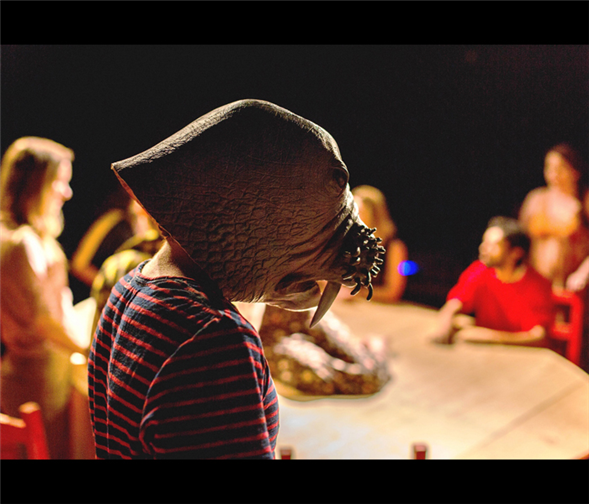The emotional logic of Rady & Bloom's latest play
---
Given what we've learned about the characters in
The Upper Room, it's incredibly moving when one of them wears a walrus mask. It's equally powerful when two of them stand on ladders and toss tiny pieces of tissue paper in the air, which flutter to the ground while a woman sings a mournful song.
Granted, these don't make literal sense. They're blatantly unrealistic, and they certainly don't advance the plot of the play, which runs through June 12 at the New Ohio Theatre. But emotionally speaking, these poetic flights are essential. They almost demand that we feel something, even if we don't know precisely what they mean.
That's a pretty good description of
Rady & Bloom, the husbands and artistic partners who have become rising stars in the indie theatre world.
The Upper Room – for which they serve as writers, directors, and set and costume designers – is the culmination of their two year tenure in New Ohio's cred-boosting
Archive Residency program, and it follows downtown hits like
Girl of the Golden West and
Peter/Wendy.
And like those previous pieces, the new show is not designed to tell you a traditional story.
"I feel like most of our work, and most of the work that I like in the world, comes from a heart place rather than a brain place," says Jeremy Bloom. "I always try to make things that feel a certain way, and I'm less concerned with the minutiae or the details of creating a complicated plot. I feel like all stories have been told, and it's more
the way they're told that's interesting to me."
At that, Brian Rady adds, "From the beginning, the evolution of this piece has always been, 'How can we have the story – the more logical, narrative stuff – serve the emotional core that we're trying to get at?'"
About that story:
The Upper Room follows a community of environmentalists who are trying to live an ecologically responsible life on an island off the coast of Maine. Their idyll of composting and soil conservation starts collapsing, however, when one of their members disappears. Did she drown in the rapidly rising ocean water that's threatening to engulf their home? Or did something more mythical occur? Is it possible she became a creature from the sea?
{Image1}
As the rest of the "back-to-the-landers" face her disappearance, the production features everything from group prayer meetings to movement interludes to tongue-in-cheek lectures about the commune's history. Therefore, even though there are few traditional scenes, we do feel grounded in this island world. We know why these people have committed themselves to this hard, elemental life, and we know what it means that it's shifting around them.
There's a scene, for instance, where a commune member stumbles on stage soaking wet. He was out diving for mussels, and something startling happened while he was in the water. As much as the story he tells, his waterlogged costume makes the strongest impression. He doesn't take it off for the rest of the show, and his dripping clothes become a constant reminder of what the world is doing to these people who are trying to care for it.
If you're detecting an eco-conscious theme, then you're right. But Rady and Bloom intentionally keep the show from becoming a scientific harangue.
"There's a danger when you're talking about political issues that it could become heavy handed very quickly," says Bloom. "We wanted to create more of an experience that resonated with people's feelings as opposed to creating a direct call to action. Because I feel like this kind of work gets more of a response, actually."
Rady adds, "As an audience member, that's how I connect to work. You can tell me something powerful, but I can just read that. What the theatre can give you is that kinesthetic, emotional, live happening. This sort of style creates something that you can't read on the page."
---
Mark Blankenship is the editor of TDF Stages
Top photo, featuring Catherine Brookman in a walrus mask, by Matthew Wells. Middle photo by James Matthew Daniel.
